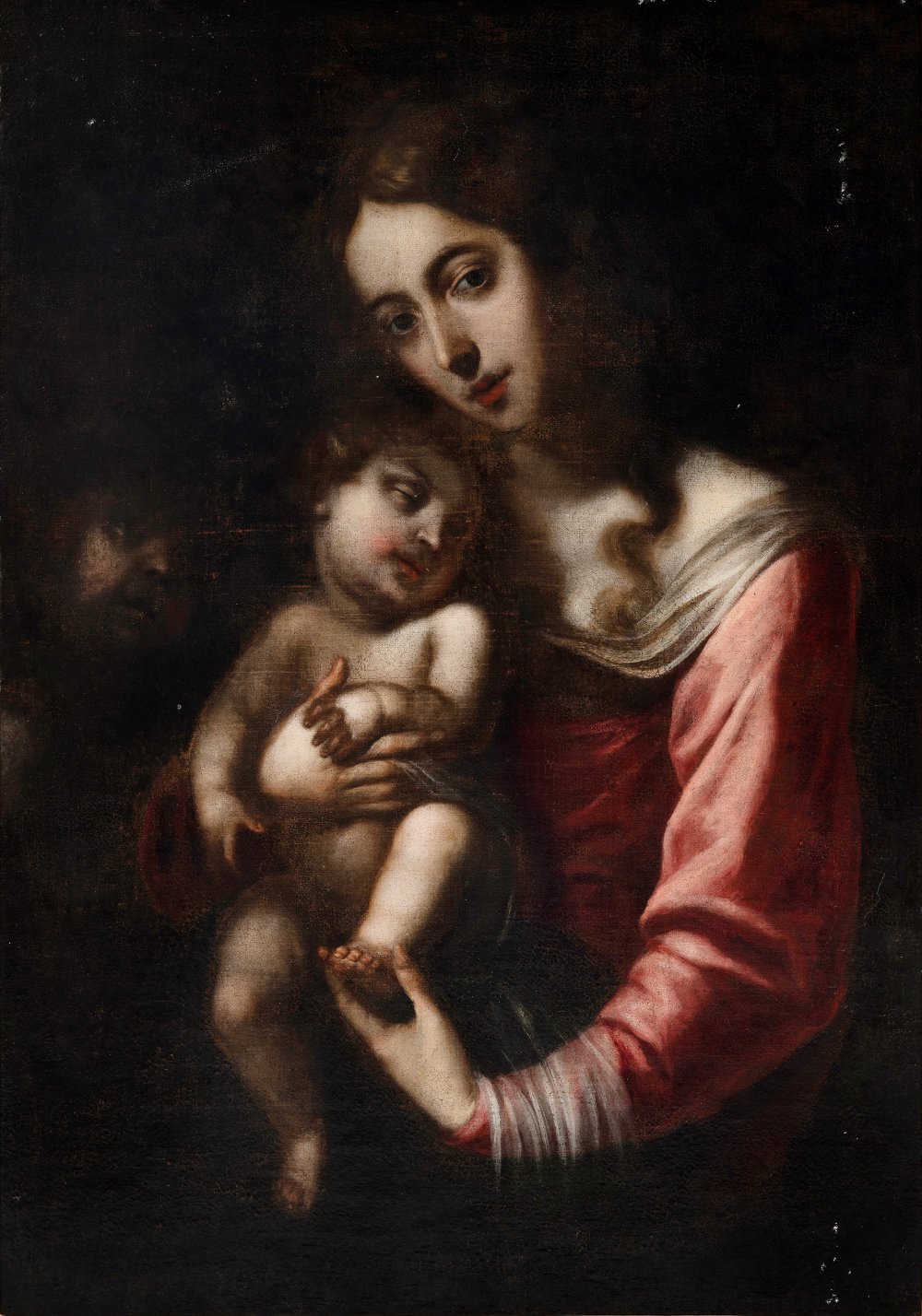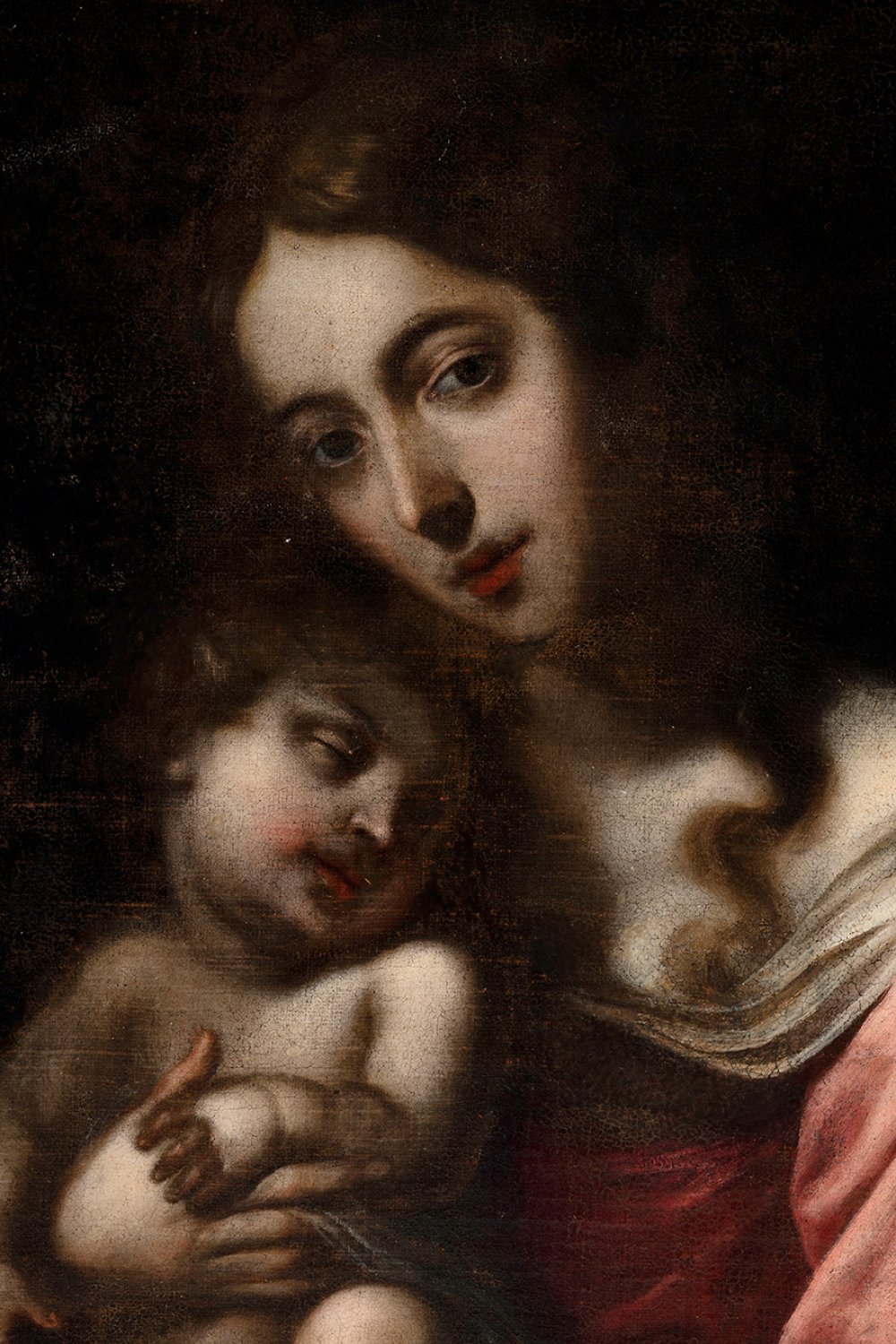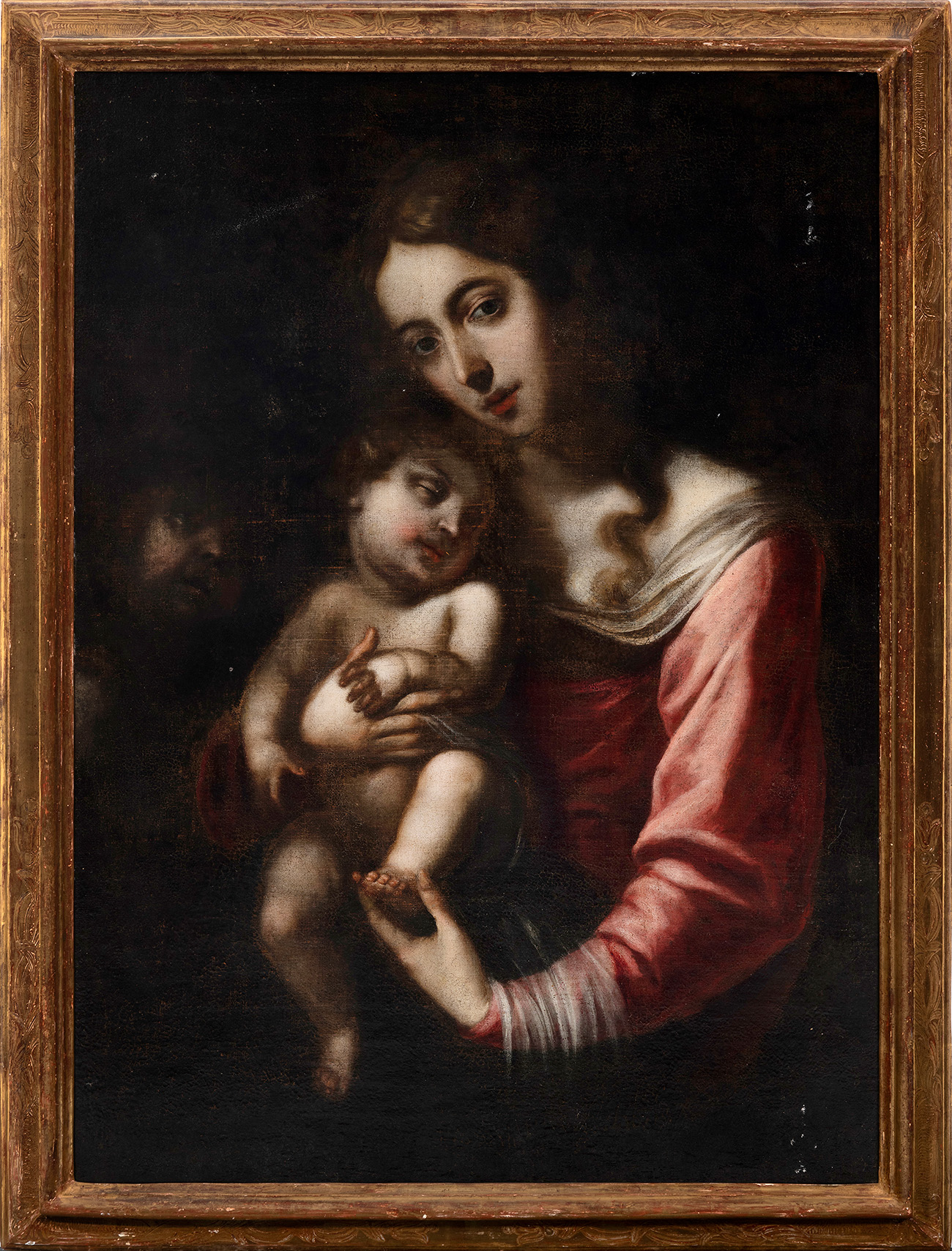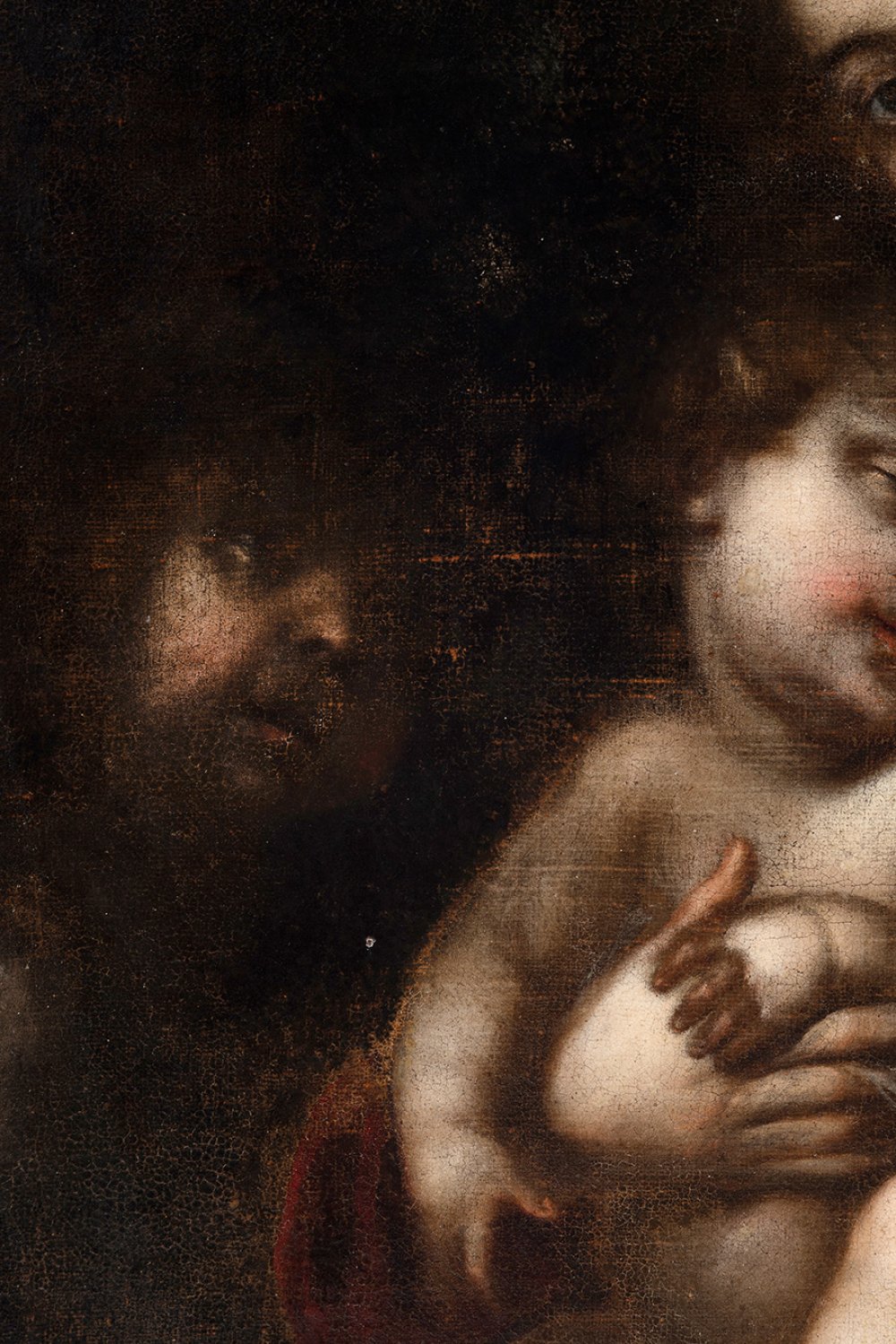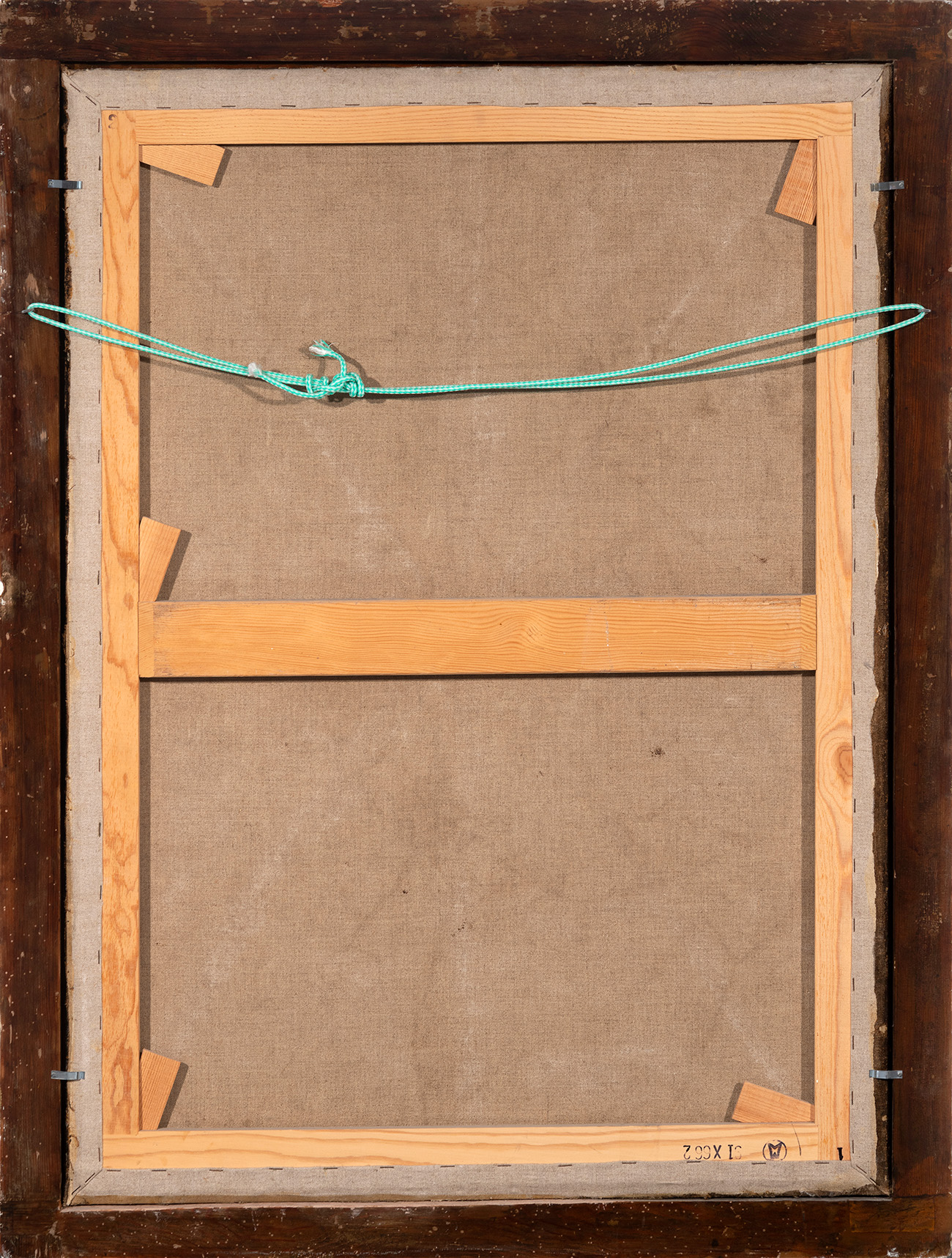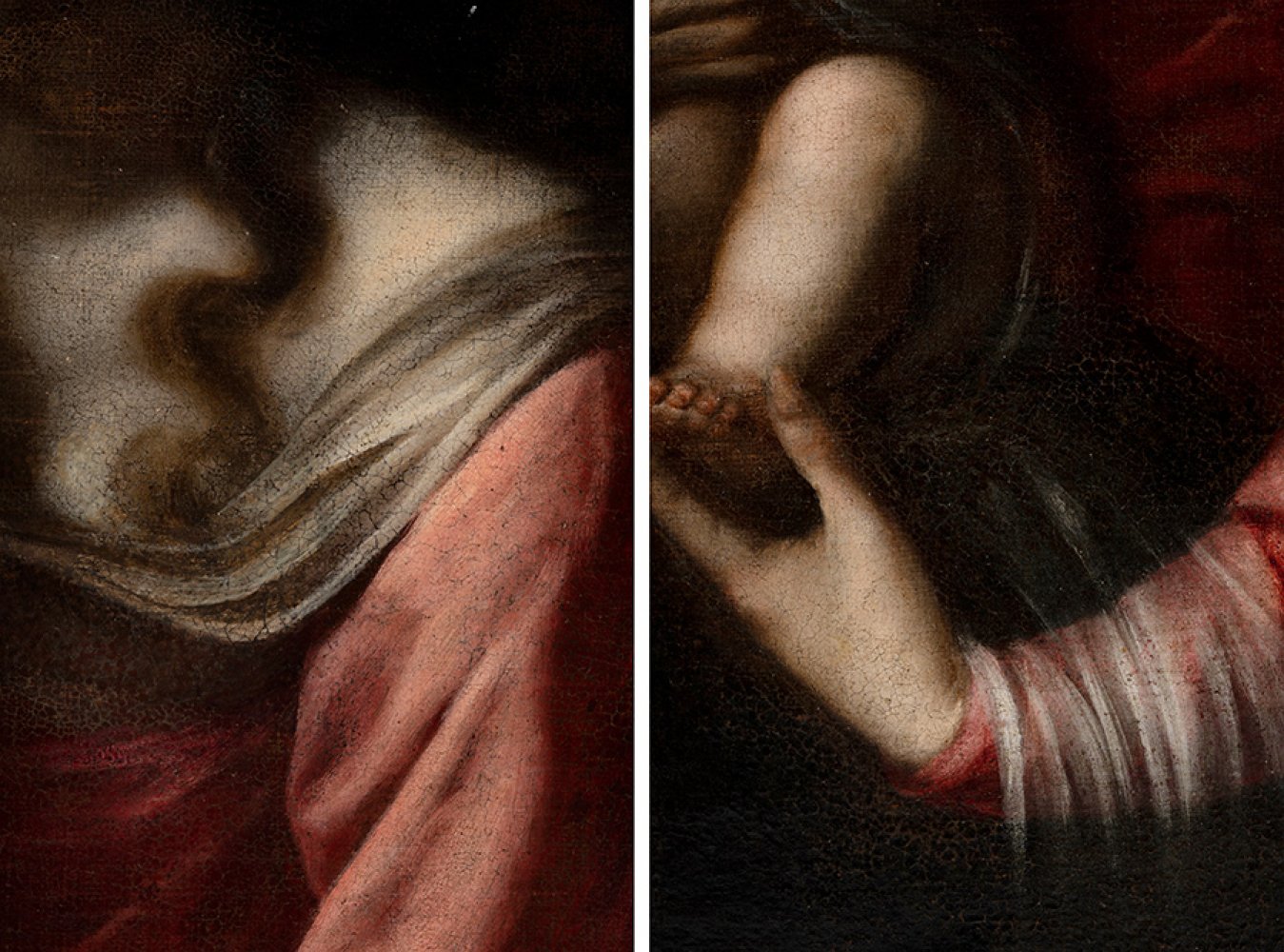19
Granada school, second half of the 17th century."Virgin and Child".Oil on canvas.Frame of the
"Virgin and Child".
Oil on canvas.
Frame of the XVIII century.
Measurements: 100 x 76,5 cm; 90 x 66 cm (frame).
A very young Virgin, of almost adolescent aspect, holds the Infant Jesus with a soft and tender gesture, taking the small infantile foot with her left hand, and leaning the little head against her chest. The painting corresponds to the subject matter, composition and technique of Pedro Atanasio, strongly influenced by Alonso Cano and Van Dyck. The love between mother and child is emphasised through a slightly idealised, extremely tender representation, with strong baroque light modelling faces and bodies. Skilful glazes reproduce the transparency of the canvases. St John's face appears on one side, looking enraptured by the scene.
During the 17th and 18th centuries, ambitious pictorial series and extensive iconographic programmes were created for churches and convents, as well as printed prints, medals and reliquaries for private devotion. As a whole, regardless of their size or medium, these images fulfilled the aim of sacralising everyday life beyond the altars. As for the Granada school, when Alonso Cano returned to Granada in 1652, he attracted all the artists to him. It could almost be said that the features that characterise the school are the features of its style. Thus, in all of them, the search for the ideal and elegant in the types, the avoidance of realism and genre scenes, paying little attention to portraiture and almost no attention to still life. Rich colour intonations abound in all of them, with specific palette preferences, such as the use of asphalt, as well as a taste for Flemish painting, which would have been encouraged by Pedro de Moya, who is said to have travelled to Flanders and England. From its style, we can relate this image to the hand of Pedro Atanasio de Bocanegra, a painter from Granada who was a disciple of Alonso Cano, Pedro Moya and Juan de Sevilla, the most active artist in Granada in the 1660s. His first known work was the decorations for the Corpus Christi festivities in his native city in 1661. During the following years we find commissions such as the series of canvases he executed between 1665 and 1666 for the cloister of the convent of Nuestra Señora de Gracia, now lost; or the numerous paintings, including the "Conversion of Saint Paul", which he painted between 1668 and 1672 for the altar of the college of the Society of Jesus, now the church of Saints Justo and Pastor (in situ). At the same time he was commissioned to decorate the Carthusian monastery in Granada with large scenes from the life of the Virgin. He was also appointed painter to the cathedral. After this period he went to Seville in 1686, and from there he left for the court of Madrid, where he was protected by Don Pedro de Toledo, Marquis of Mancera. Thanks to the influence of his protector, Bocanegra was awarded the title of painter to the king "ad honorem" for his painting "Allegory of Justice", inspired by a mid-16th-century Venetian print and now in the Royal Academy of San Fernando. After his stay in Madrid, Pedro Bocanegra returned to Granada. In addition to the aforementioned art galleries and religious centres, works by this master can now be found in the Zaragoza Museum, the Goya Museum in Castres, the Diocesan Museum of Sacred Art in Vitoria and the Fine Arts Museum in Granada, as well as in various private collections.
"Virgin and Child".
Oil on canvas.
Frame of the XVIII century.
Measurements: 100 x 76,5 cm; 90 x 66 cm (frame).
A very young Virgin, of almost adolescent aspect, holds the Infant Jesus with a soft and tender gesture, taking the small infantile foot with her left hand, and leaning the little head against her chest. The painting corresponds to the subject matter, composition and technique of Pedro Atanasio, strongly influenced by Alonso Cano and Van Dyck. The love between mother and child is emphasised through a slightly idealised, extremely tender representation, with strong baroque light modelling faces and bodies. Skilful glazes reproduce the transparency of the canvases. St John's face appears on one side, looking enraptured by the scene.
During the 17th and 18th centuries, ambitious pictorial series and extensive iconographic programmes were created for churches and convents, as well as printed prints, medals and reliquaries for private devotion. As a whole, regardless of their size or medium, these images fulfilled the aim of sacralising everyday life beyond the altars. As for the Granada school, when Alonso Cano returned to Granada in 1652, he attracted all the artists to him. It could almost be said that the features that characterise the school are the features of its style. Thus, in all of them, the search for the ideal and elegant in the types, the avoidance of realism and genre scenes, paying little attention to portraiture and almost no attention to still life. Rich colour intonations abound in all of them, with specific palette preferences, such as the use of asphalt, as well as a taste for Flemish painting, which would have been encouraged by Pedro de Moya, who is said to have travelled to Flanders and England. From its style, we can relate this image to the hand of Pedro Atanasio de Bocanegra, a painter from Granada who was a disciple of Alonso Cano, Pedro Moya and Juan de Sevilla, the most active artist in Granada in the 1660s. His first known work was the decorations for the Corpus Christi festivities in his native city in 1661. During the following years we find commissions such as the series of canvases he executed between 1665 and 1666 for the cloister of the convent of Nuestra Señora de Gracia, now lost; or the numerous paintings, including the "Conversion of Saint Paul", which he painted between 1668 and 1672 for the altar of the college of the Society of Jesus, now the church of Saints Justo and Pastor (in situ). At the same time he was commissioned to decorate the Carthusian monastery in Granada with large scenes from the life of the Virgin. He was also appointed painter to the cathedral. After this period he went to Seville in 1686, and from there he left for the court of Madrid, where he was protected by Don Pedro de Toledo, Marquis of Mancera. Thanks to the influence of his protector, Bocanegra was awarded the title of painter to the king "ad honorem" for his painting "Allegory of Justice", inspired by a mid-16th-century Venetian print and now in the Royal Academy of San Fernando. After his stay in Madrid, Pedro Bocanegra returned to Granada. In addition to the aforementioned art galleries and religious centres, works by this master can now be found in the Zaragoza Museum, the Goya Museum in Castres, the Diocesan Museum of Sacred Art in Vitoria and the Fine Arts Museum in Granada, as well as in various private collections.
13th October - Old Masters
Sale Date(s)
Venue Address
General delivery information available from the auctioneer
Setdart offers Worldwide shipping
PICK UP IN ROOM: You can come and pick up your lots in our offices (Barcelona, Madrid or Valencia). At the moment of the withdrawal, you will be able to accept the current conditions of the lot by means of a document that you will sign.
YOU CAN SEND ANOTHER PERSON TO PICK UP: This person must present a signed authorization that you can find in our web page by accessing from BUY AT SETDART- LOGISTICS-DOWNLOAD AUTHORIZATION DOCUMENT. You can also send an e-mail with the requested data in AUTHORIZATION DOCUMENT to admin@setdart.com
Important Information
25% buyer´s premium
21% buyer´s premium at www.setdart.com
Terms & Conditions
The maximum period to pay the lots is 7 working days. You can pay either via bank transfer or with credit card through our platform www.setdart.com (we only accept VISA or Mastercard).
BUYER´S PREMIUM: 22% Hammer price + 21% VAT from the buyer´s premium
If your piece has more than 100 years, our Ministry of Culture requires an export certificate in order for the piece to leave the country. Note that if the piece goes inside the EU, there is no cost for the export certificate. If the piece goes outside the EU, there is a cost for the export certificate. You can find more information in our Ministry of Culture website: https://www.culturaydeporte.gob.es/en/cultura/patrimonio/exportacionimportacion/exportacion/tasas.html
INQUIRIES: admin@setdart.com
Setdart guides you through the entire process, from the time of award to the day you receive your lot. Our logistics team will be happy to manage your transport, and will advise you on the best shipping method with professionals from the sector used to handling works of art and jewelry.
WE OFFER WORLDWIDE DOOR TO DOOR SHIPPING
PICK UP IN ROOM: You can come and pick up your lots in our offices. At the moment of the withdrawal, you will be able to accept the current conditions of the lot by means of a document that you will sign.
YOU CAN SEND ANOTHER PERSON TO PICK UP: This person must present a signed authorization that you can find in our web page by accessing from BUY AT SETDART-LOGISTICS-DOWNLOAD AUTHORIZATION DOCUMENT. You can also send an e-mail with the requested data in AUTHORIZATION DOCUMENT to admin@setdart.com
SETDART IS NOT RESPONSIBLE FOR THE STATE OF THE PARTS ONCE THEY LEAVE OUR FACILITIES. MRW SHIPMENTS: Once the payment is made, your lot will be packed for shipment, the logistics department will send you an e-mail notifying you of the day it leaves our warehouse, changes of address cannot be made after receiving this e-mail.
INSURANCE INCIDENTS: Coverage for the value of the auction up to 3000 ? per shipment, if the value of the auction is higher, Setdart will send you a quote including the additional insurance. The insurance company WILL NOT BE RESPONSIBLE FOR THE SHIPMENT THAT EXCEEDS THAT AMOUNT AND IS NOT FULLY INSURED. MRW INCIDENTS: Maximum notification 48 hours after receipt, after which the insurance company WILL NOT BE RESPONSIBLE AND NO CLAIMS WILL BE ACCEPTED.
E-MAIL LOGISTICS: logistica@setdart.com
PICK UP YOUR MESSAGES: You can send your own messaging, prior notice via e-mail that your shipment is ready, please note 3 or 4 days in advance. This type of shipment is packaged so Setdart will provide you with a quote.
EXPENSES FOR STORAGE: We inform you that if the purchased lot is not picked up within a month, you will be charged 30€ per week per lot. Setdart Online S.L., owner of the web site "setdart.com", "setdart.net" and "setdart.org", acts as a company of Spanish nationality inscribed in the Volume 36955, sheet 182, page B-293056 of the Mercantile Registry, with registered office at Calle Aragó















